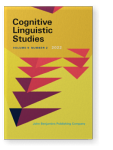Vol. 9:2 (2022) ► pp.202–222
What does image schema facilitate in English L2 vocabulary processing?
The effectiveness of schematic visual aids for the enhancement of metaphoric competence in learning phrasal verbs
This study aims to examine the effectiveness of image-schema-oriented visual aids to cohesively process the semantic information of English (L2) phrasal verbs (PVs), leading to the proper understanding of their senses. As previous studies suggested the advantage of image-schema-based L2 vocabulary learning, our study hypothesizes that image-schema-oriented visual aids in a multimedia environment can develop the motivated semantic networks of L2 PVs, leading to their successful processing and comprehension. To verify the hypothesis, we administered two empirical studies to Japanese undergraduates learning with image-schema-oriented visual aids. Although they were administered in different settings, both studies showed that the participants could obtain significant learning gains, especially figurative meanings. This finding suggests that the use of image-schema-oriented aids could successfully process semantic information of L2 PVs enough to develop a motivated semantic network and reconfirm the significance of image schema in terms of enhancing learners’ metaphoric competence.
Article outline
- 1.Introduction
- 2.Literature
- 2.1Phrasal verbs
- 2.2Image schema as visual aids for polysemous words
- 2.3Image schema as a computational visual aid
- 3.Research
- 3.1Research questions
- 3.2Research 1
- 3.2.1Participants
- 3.2.2Target PVs
- 3.2.3Treatment
- 3.2.4Procedures
- 3.2.5Analysis
- 3.2.6Results
- 3.3Research 2
- 3.3.1Participants
- 3.3.2Material
- 3.3.3Treatment
- 3.3.4Procedures
- 3.3.5Findings
- 4.Conclusion and discussion
-
References
